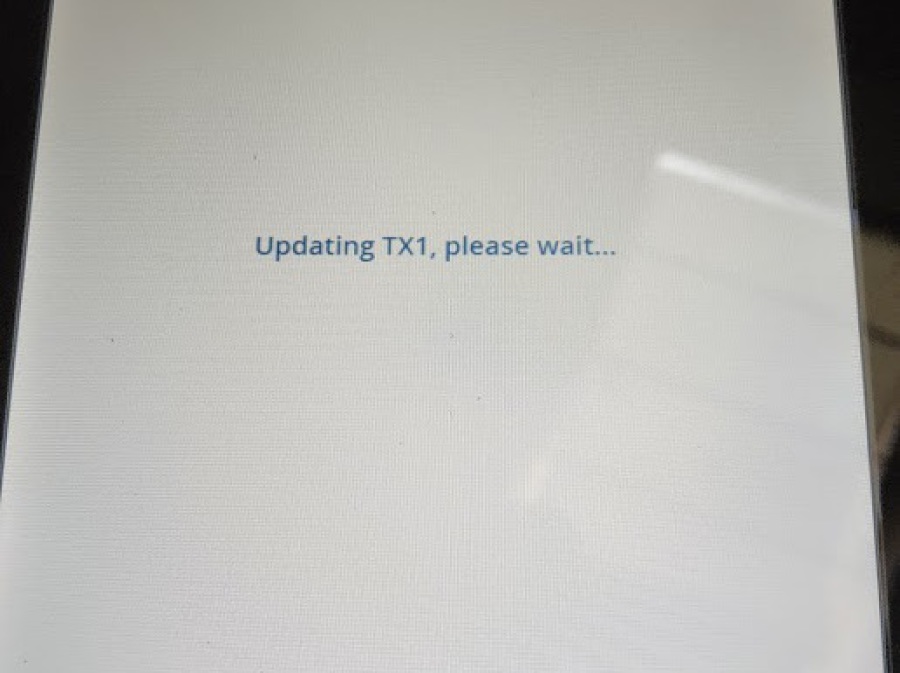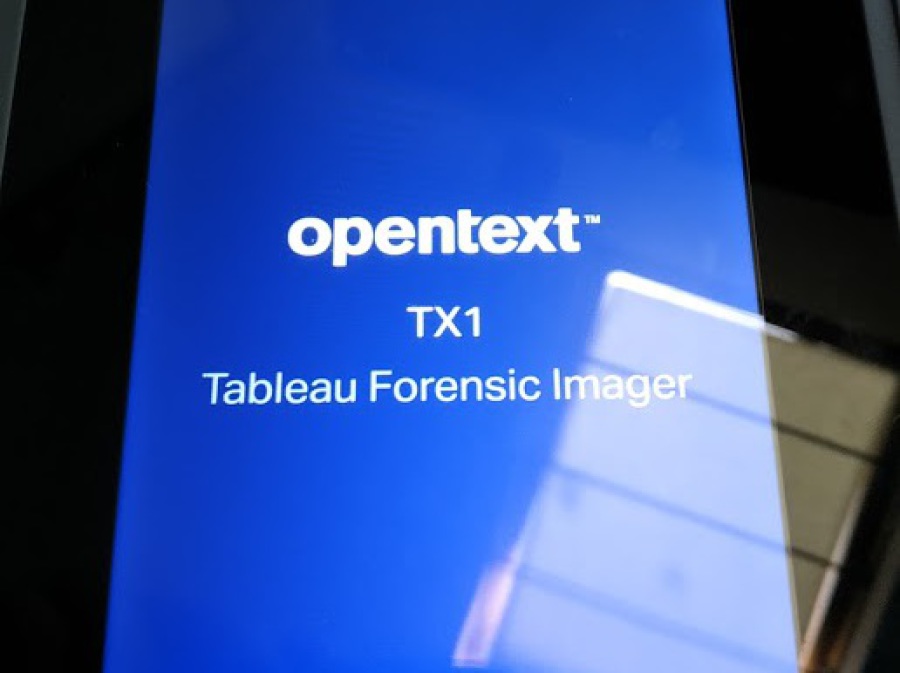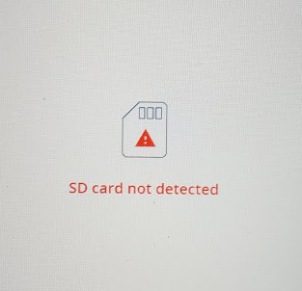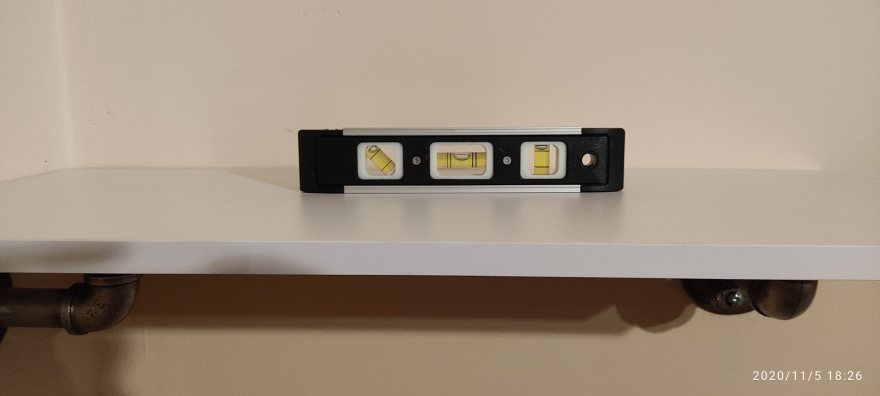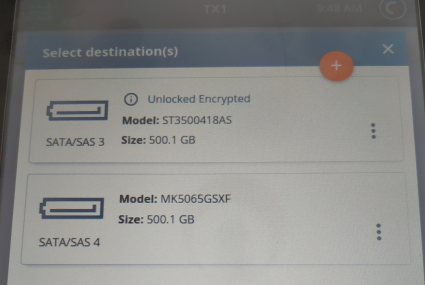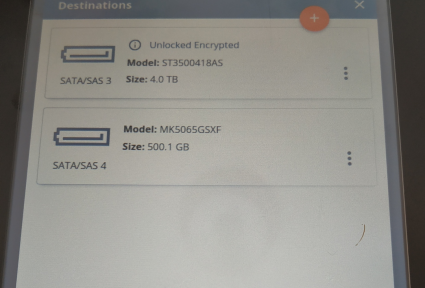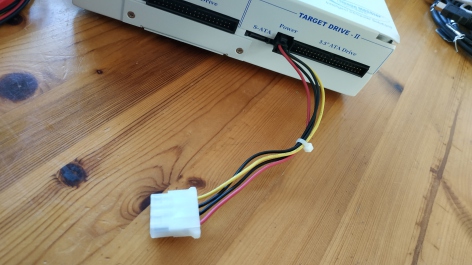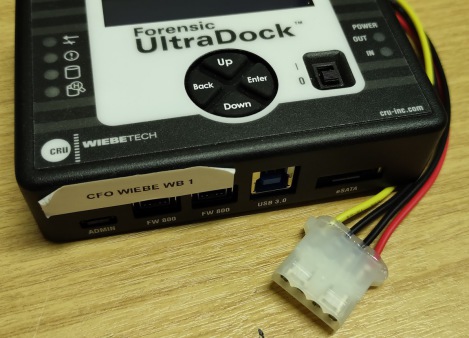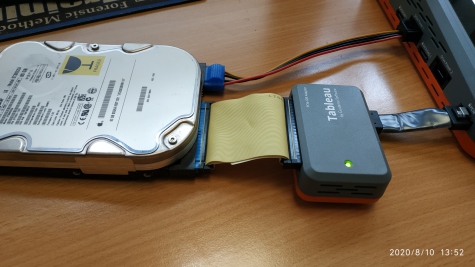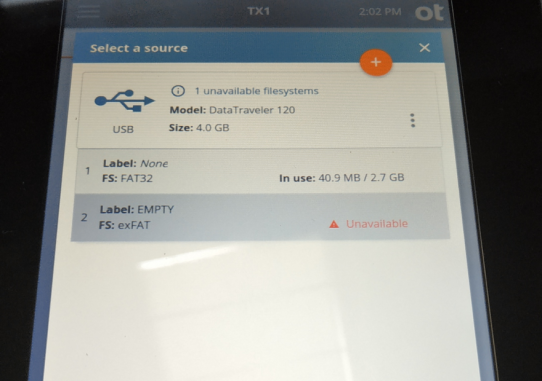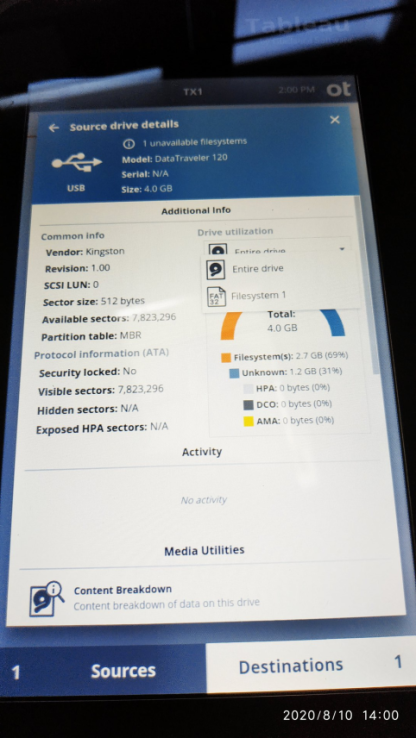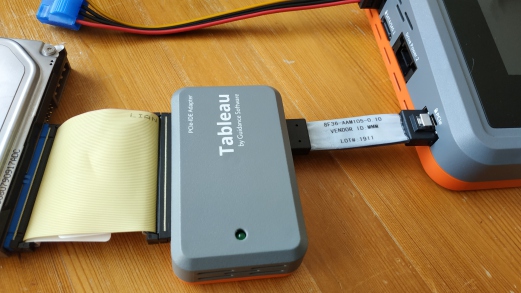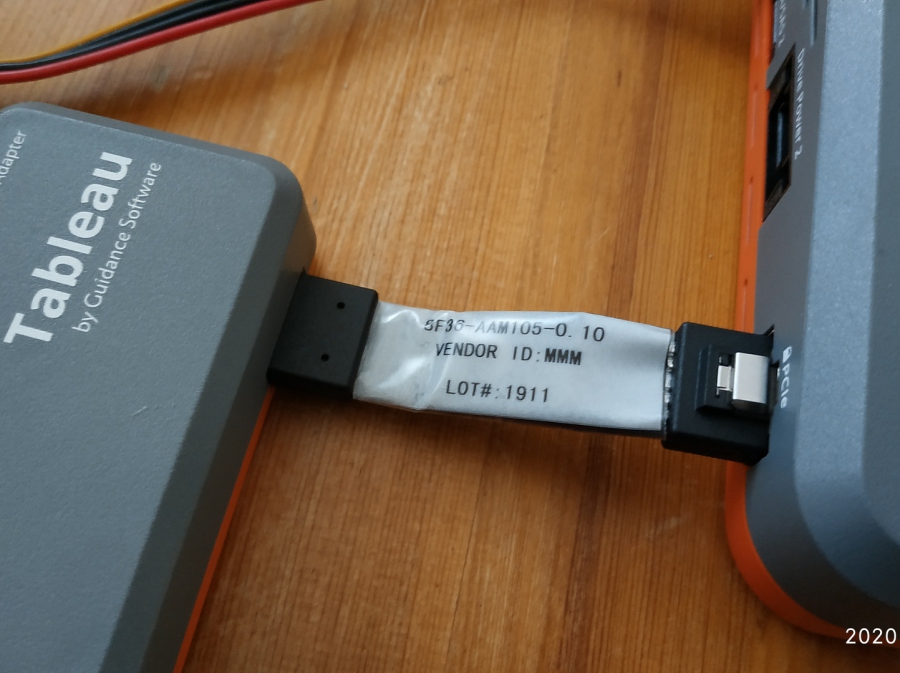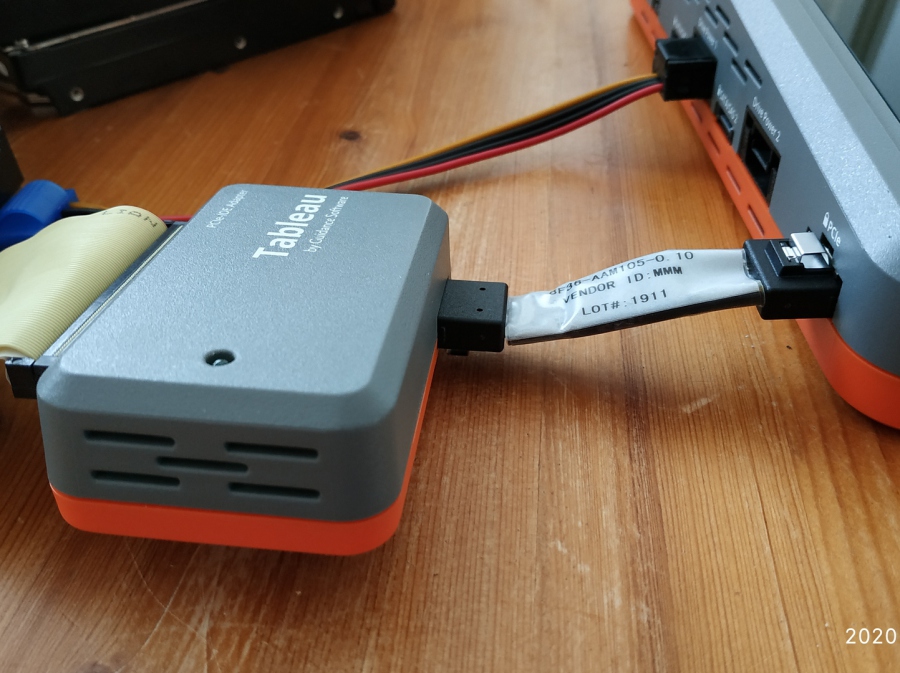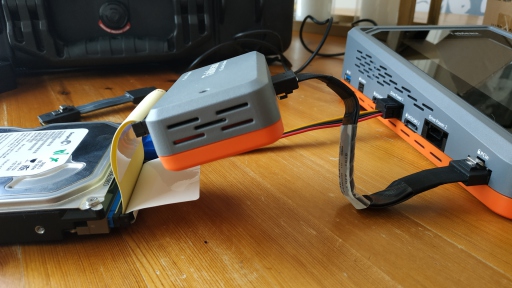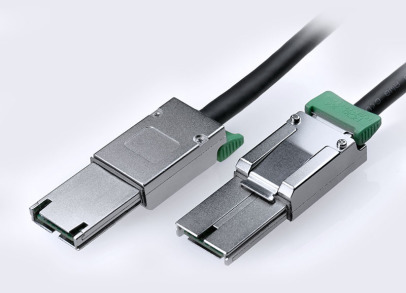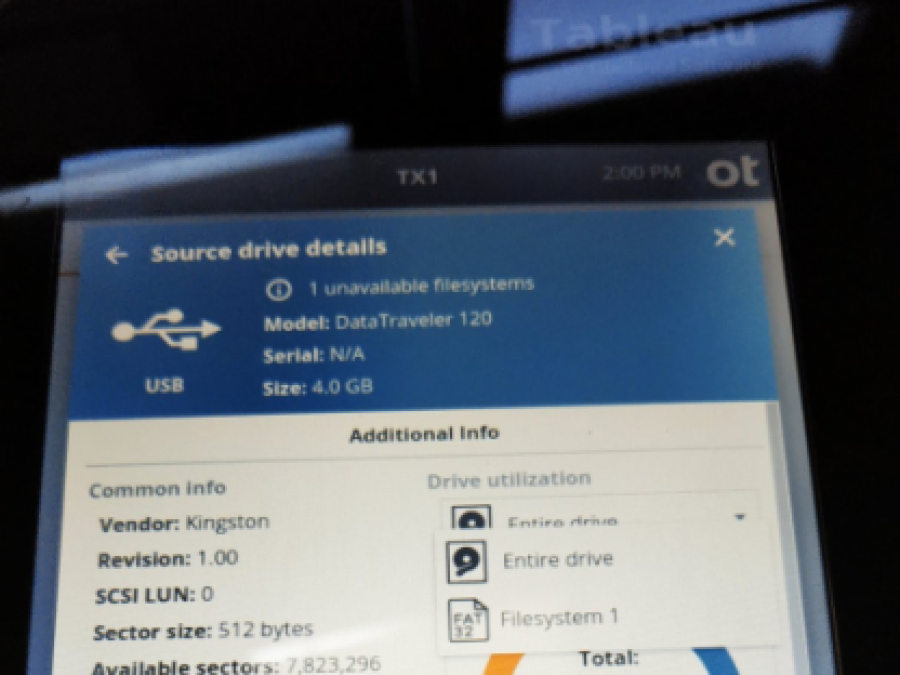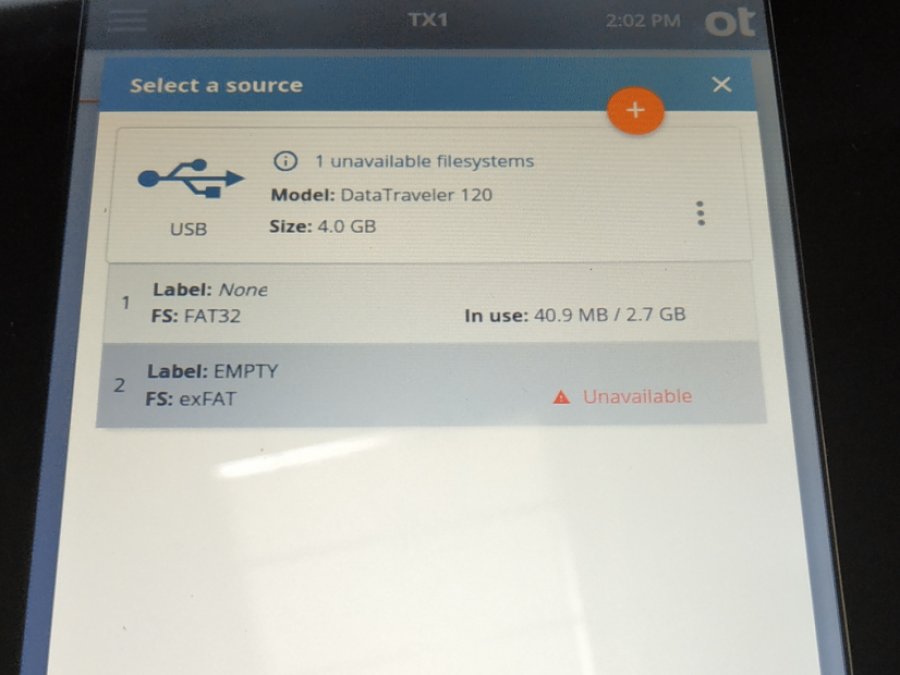22. Firmware & Updates - Continued....
Right, were where we ?.... oh yes, firmware;
Being the nosy type, I had a rummage around the TX1's firmware SD card, not much to see - its just a bog standard 4GB card;
I'm not a fan of firmware on an SD card, thats a very noughties way of doing things, I would have preferred the unit to have proper flash memory built in and the SD card was only a conduit to get the new firmware into the unit.
I know that I would be making a duplicate of this card (they are not the most reliable media on the planet), so that if it does run into an issue, I can quickly get the unit back up and running again. I did not see any obvious copy protection of the firmware on the SD card so hopefully that method would work, but to be honest, I did not look that hard.
The review unit booted up with the new firmware in place, and other than a nice new blue OpenText logo (shown below) things looked pretty much the same and the unit operated as expected - remember to check the release notes of any firmware to see the new features and fixes.
I would backup any log files you have on the unit, just in case there is a problem during the update process and they are lost.
ProTip: For those not familliar with firmware, its programming code that makes the unit tick, its also something that you don't play with on-site when you are imaging data and its also something you don't fiddle with if you are just about to go on site for a planned job.
It is very easy to "brick" a device (its not going to work ever again) during a firmware update (power cut or a crash as two examples) which leaves you without an imaging unit. My advice is to update the unit a few weeks after new firmware has been released (and check back on the vendors websites to see if there have been any revisions) - then do a few images in the lab to ensure the unit still functions as desired before taking the unit into a production environment onsite.
Don't Lose the Firmware Card
Being the naughty little tinker that I am, I was curious as to how the TX1 would handle having its firmware card removed (whilst the unit was powered off), I was greeted with the following error - replacing the card and booting up returned the unit to working order. So note to self - don't lose this card.
As I didn't want to risk damaging the TX1 that Steve had kindly lent me, I decided against popping out the firmware card whilst the unit was powered on. I would expect this would lead to the unit hanging (unless it copies the whole operating system to RAM on boot up), but remember that your log files are stored on this card - and mucking about with it could put those at risk! So as Jacky Gleason once said in Smoky and the Bandit, "you can think about it.....but don't do it".
Anyway, put a bit of tape over the slot and all should be well.
23. Product Stability:
If something is not stable - meaning it crashes or hangs, it is not something that I would be able to recommended. In our industry time is money and having to repeat something due to equipment failure has a tangible cost and shrinks the bottom line.
Thankfully the TX1 is rock solid I'm still smiling about the torture test carried out elsewhere in the test and the zillions of images and logical image files I made during this insanely long testing/review period I spent with the TX1.
I have absolutely no qualms in giving it an excellent rating in this scoring category, if you have managed to crash the device whilst using it - I'd like to know about it.
Even throwing curved balls to the TX1 (known corrupted file systems, damaged hard disks and "iffy" memory sticks) I was unable to make it throw its toys out of its pram and crash.
If you want something that has almost military levels of robustness (with one exception we will discuss in the issues section) and is a crash free experience, the TX1 is it.
I'm actually dissapointed that I couldn't make it fall over.
24. Alternative Products:
As always, there are a number of other products out there that are direct competitors with the TX1, I haven't used any contemporary alternative units, so can't really recommend anything to you.
I'm a sad old Linux boot disk and Guymager person with a long beard and food stuck in it from my crumpets and jam I had for tea last night.
However, you should be aware that other competitor units have far more features than the old TX1, such as Cloud data acquisition (One Drive, Google Drive, Drop Box etc), the ability to image fibre channel hard drives, and the ability to multi task on a much larger scale than the TX1 can.
I don't think there is any reason why the TX1 could not have these features added at some point in the future - it would be nice to see a roadmap from OpenText, but I think that after 5 years of development there has to be a point of where the next-gen unit is designed to encompasse all of the very latest features.
You can view Logicube products here, Atola have a small range here and Intelligent Computer Solutions (ICS) have their offering here. If you are in need of a budget device, Voom have a no frills "phyiscal image" of SATA/PATA drives at the touch of a button device here.
I would *really* like to get my hands on a few of these units and see how they perform, as I am sure there are lots of you out there who are in the market for a hardware imager, but need an in-depth review to see if it is for you !
The Head-2-Head that Never Happened:
This review was meant to be an exciting "head to head" review, with the TX1 being put up against against a Logicube hardware imager. The UK distributor agreed to send me a unit, but after several E-Mails and one stating that they could not submit a unit for long term test - they lost interest and never got back to me.
If anyone knows anyone in the US head office, or anyone from Logicube is reading this and has some clout, please get in touch here ! I'd love to put your product through the CFRO meat grinder.
25. Bugs and Other Issues:
Things have changed a bit on the bugs and issues side of things, after listening to your feedback I've decided to consolidate all of the issues I encountered into one section - instead of writing about them as they happen inline with the rest of the review text.
I think this improves the flow when reading, its probably a bad idea for my page hit count, as no one will read the body text any more and come straight to this section :)
This section is here for two reasons;
1. To help you avoid issues if you purchase this product.
2. To allow the vendor to work on fixes.
I'm one of those annoying people that insists that things are done by the book, which provides consistent and reliable results, just look at this shelf I put up at the weekend, I expect my "forensic" tools/hardware to operate to that same consistent high standard, day in, day out.
Issue 1 - Intermittent Drive Size Detection Errors:
Ok, so eyes down for a full house, first up is a problem with how the TX1 calculates the size of encrypted drives that are attached, as you can see in the screen-shot below, the TX1 has a 500GB drive (left image) attached which I was merrily storing image files on. After a few operations, that magically gets detected as a 4TB drive (right image).
This encrypted drive [above] is using the proprietary encryption system that the TX1 uses to encrypt destination drives, its not Bitlocker but works in a similar fashion.
I suspect this bug has been present in the TX1 since day one (2017) and is or may already have caused someone to have a really bad day if this leads to corruption of the disk when it tries to write past the 500GB capacity of the drive.
With this discovery, there is no way that I would be using the TX1's encryption feature in a live production environment, as I simply could not trust it and more so, members of my team may not notice that the drives capacity has magically increased until its too late.
I found this bug after around 5 minutes of playing with the encryption feature.
Update: I reported this to OpenText several months ago, they have acknowledge this is a bug and have since patched this issue in a firmware release that will be available when you read this. Now that this is patched, I would not hesistate to use the encryption feature onsite.
Issue 2 : Weak Accessibility Features:
The TX1 has half-baked accessibility features.
I'm most disappointed with the "pinch to zoom" function which can be used to magnify the screen in a similar way to the Windows Magnifier tool.
Pinch and zoom only works on certain parts of the GUI, so if you are visually impaired in any way, or members of your team are, be warned that you can't zoom everything. Make sure you get a trial of this unit to ensure the accessibility features meet your needs.
I would like to think that OpenText will address this issue, but I think this may be a limitation of the TX1's operating system - so lets hope that a firmware update in the future can bring the ability to pinch and zoom anywhere on the screen, giving true accessibility to the visually impaired.
An HDMI port would have been a nice feature (as we already have 2 USB accessory ports for a Keyboard and Mouse) so a port for an external display is a missed opportunity.
Issue 3 : Drives Dropping When Removed from Base Expansion Unit:
When a 3.5" SATA desktop hard drive is pulled out from the TX1's underbelly expansion unit the intuitive way to do this is to pull the drive out using two fingers in a horizontal manner - so the drive remains flat inside the unit and remains so when it slides out onto the table when leaving the underbelly unit.
When a drive is pulled out of the TX1, it drops off the SATA controller's connectors [inside the underbelly unit] and drops down 3mm or so onto the drive tray within the base unit of the TX1. With a clunk. This happens inside the unit, before the drive leaves the slot - you can see the connectors inside the unit in the picture below.
Drives have to be held at all times when you pull them out, in a horizontal and then upward movement, to "catch" the drive before it drops down.
This is in my opinon, is not the cleverest of designs and is an unecessary risk to your drive.
Having said that, It is easy to get the knack of pulling drives out (out and up) without letting go, to avoid this issue, but thats not ideal. I would ensure my team was made aware of this to avoid potentially damaging drives. Not all examiners are as caring and respectful of hard drives as perhaps I am!
As this is not fixable due to being a hardware design issue, I would like to see at least a reference to this in the manual. You could slide something thin into the TX1 under the hard drives you insert, but thats not an ideal solution either.
Issue 4 - Disk Spinning Whilst Ejected:
As you may recall from the main review text, the TX1 offers a nice convenience feature to "Eject" a disk from the system via the GUI. The only problem is that it does not spin the drive down (its a Software only eject) - so when you pull the drive from the unit, whilst its filesystem is cleanly dismounted - it is still spinning.
Thats another ill thought out design decision and I just can't see how anyone would think that its ok to pull a spinning drive out from a SATA connector. Couple that with the "drive-drop" (Issue 3) and in my book you have a recipe for disaster.
As I've said before, you won't know if you have damaged a disk by pulling it out of the TX1, not until you try to re-read the drive and come across damaged areas.
SAS enterprise drives spin at 15,000 rpm and are *not* going to be happy when subjected to this sort of abuse.
You can completly mitigate this by powering the TX1 off before removing any drives from it (which is how I would operate the TX1 if I was an owner, but that is not the manufacturers intended method of operation.
I reported this to OpenText and they wrote back saying they had thought about spinning drives down before - but as they had no way to cut power to the drives [as competitor units do] they didn't implement spin-down due to not all drives supporting the command. To me that is a weak sauce argument and in my experience the vast majority of contemporary and all but the oldest legacy PATA drives support the spin down command.
Update: A few months later, I was informed that OpenText had re-thought their initial response. They decided to reprogram the disk ejection routine so that drives do power off and spin down when they are ejected.
OpenText added this in their release notes;
- OpenText has always recommended ejecting media (using the soft Eject function available in the Media Utilities list for each connected drive) to help ensure reliable drive and partition/filesystem operation after removal of the drive. But the Eject feature has become more valuable with the addition of a drive spin down command being issued. For rotating media that support it, ejecting the drive will now help ensure that the platters are spun down, which will significantly decrease the chance of media damage during physical removal from TX1. [TBL-4038]
I'm sorry guys but most of your customers are not idiots, so please don't treat them like they are. You are skirting around a serious issue here that users have been are unplugging drives that are spinning at full speed since 2017 - which is a recipe for disaster.
I'm not done with this yet, here is an extract from a newly added paragraph in the 20.4 user manual;
Did that really happen? I mean I am fan of Rock & Roll, but not when I am handling evidence.
I'd love to say that I picked up a random power cable from my desk instead of the one supplied with the TX1, but that would be a fib, this is what OpenText actually supply you with.
Allowing desktop hard drives to rock on the table is frankly is a bad idea - on a similar level to unplugging them when they are spinning.
These blue molex power connectors are for hard drives that are in a chassis, in a 3.5" bay in a PC case, where there is nothing for the lugs to catch on, these are not designed to be used on a table or other flat surface - which is where all of my imaging (and probably everyone elses on planet earth) is done.
ICS (and all of OpenTexts competitors) got this right with the Image Master Solo 3 way back - ten years ago (below top) and WiebeTech (below bottom). Those Wiebetech units are amazing, remind me to do a review!!!
Bending off the bottom lug on that blue power connector allowed drives to safely sit on the table, which was a relief! (image below).
I would like to think that OpenText have changed the cables in units currently in the supply chain, so be sure to look out for this if you purchase one - you can modify the cable yourself if they are still shipped like this.
Issue 6 - Logical Evidence File (LX01) Issues:
Take a look at this picture (below) showing the contents of an LX01 file created with the TX1 - see if you can tell what is missing (click to enlarge);
I found that the TX1 was not recording file creation dates when it was capturing individual files to a logical evidence file (.LX01). The LX01 you are seeing above contains a bunch of files from a few folders and was a super simple test to see if there was any issues.
For me this would be a deal breaker on a TX1 purchase, it would render entire collections of EFILES (documents and other file types) useless - as when ingested into a forensic analysis tool (or Ediscovery system such as Relativity or Concordance) the date of creation would be unavailable.
This wasn't a one off, I tried several LX01 files and the results were sadly the same, below I'm looking at TX1 log file, just to see if the dates are here for some reason and not in the LX01 itself;
Just to check that I had not lost my mind, I fired up EnCase 8.x, created a fresh LX01, it had creation dates as expected;
I reported this to OpenText because I was sure I had done something wrong - as soon as I noticed this behaviour....
The official response was along the lines of "you are not doing anything wrong, the TX1 does not store file creation dates within logical evidence files", they also said something along the lines of "our customers don't have an issue with this". They then went on to say something like "they were looking to implement this in an upcoming version of the TX1's firmware".
Not sure about you readers, but your humble reviewer has never heard of collecting files from a disk or other media without recording their creation dates. This official response also means they are essentially telling us that since 2017 when the TX1 was released - all customers creating logical evidence files have not been worried about creation dates being missing?
I'm really struggling to believe that answer.
Trying to be positive, I'd like to think this is a bug with my unit or this issue has been introduced recently in a firmware update - as I would imagine a lot of unhappy customers would be venting their frustration if this is intended behavoir.
I hope that this has been fixed in a firmware update that has been released by the time you read this review, but if I were a prospective purchaser I would want to confirm that these dates are now being recorded properly to avoid disappointment (and potentially recollections) later down the line.
Issue 7 - File System Detection Errors:
The TX1 boasts support for many file systems, which is good, so I put together a simple test, which didn't go so well.
A simple USB device will have a single partition, usually the size of the entire flash memory it contains, and others with encryption will have two paritions or even emulate a CDROM drive until the correct password is entered.
What if you are a cheeky chappy and have two partitions, with differing file systems on the same USB memory stick.
This is perfectly permissible and something that can be done from within the bog standard Windows Disk Manager console snap in. So this is not something that breaks rules or is impossible to come across in the wild.
I had a 4GB memory stick with a 3GB or so FAT32 partition and then a second exFAT partition of around 1GB where I kept my porn stash. As shown below, the TX1 was not at all happy about the presence of the second exFAT partition and flagged it as "Unavailable".
Thats very odd, lets try and explore this in the TX1's built in partition and file system viewer;
Hmmm, no dice we are only shown "File System 1" which is the first partition on the disk - the second partition is still "Unavailable".
Plugging this same memory stick into a bog standard Windows 10 machine, showed this in disk manager;
and yep, you guessed it, I was able to access the E: exFAT partition with Windows Explorer without any problems. If I was a naughty custodian in an E-Discovery litigation, I'd just managed to keep a set of files (that are in plain sight on the memory stick) from being copiedby the TX1 if the examiner was doing logical (LX01) collections and using a pre-defined workflow to copy drives en-masse - eeek.
The user manual states there is "extensive" support for exFAT file systems (Page 11, V20.4), so why does this not work ?
To be clear, this is not going to effect the TX1's ability to make a good physical image of the USB stick, but its just a little bit worrying to see that it can't handle this combination of decades old file systems.
Update: It looks like Opentext may have fixed this as there is something in the changelog for the latest firmware stating that drives with an extended partition were previously inacessible and that they are now.
Issue 8 - Unable To Disable DCO or AMA's on PATA drives:
When I was testing the PATA/IDE adapter box (that hooks up via that daft PCIe cable) the TX1 informed me that it cannot shelve (disable) DCO/AMA's from drives that are attached via the PCIe interface.
What this means in English is that if you do come across a PATA drive that has these areas (sectors of the disk that have been hidden from the drives controller by a manufacturer or criminal), you can't image those sectors with the TX1. There is no way to turn off the DCO!
I've not delved into why the TX1 can't switch DCO's and AMA's off, but I would assume that is something to do with the translation of the ATA command set when the PCIe adapter is connected.
Whilst this may not be a major problem these days - as you don't see PATA drives that often, its still an ill thought out design decision in my opinion. If the TX1 had a dedicated PATA port and associated controller, this would not be an issue.
ProTip: DCO's were introduced if my memory serves me correctly in the ATA-6 standard (also known as Ultra DMA 100 for those that can remember that far back) and in case you were wondering, SATA (PATA's successor) came along in the ATA-7 specification.
Issue 9 - Disk Encryption Feature Formats Drives
During the testing of this feature, I accidentally wiped a test drives file system, as the TX1's disk encryption function gave the impression that it was going to encrypt the disks existing file system in place.
Unless I missed it, no warning was given on-screen that the process was destructive in this way.
If used incorrectly in the field, you would kiss goodbye to a disk full of images in a worst case scenario. This is not Bitlocker, it does not encrypt anything in place!
Reading the user manual will warn you that this process is destructive, but in lieu of that, a nice prompt on-screen would help new users avoid this Gotcha.
Update: I've heard back from OpenText and they have updated this feature to indicate to the user that the process is destructive.
Issue 10 - HPA Detection Unreliable:
I found that the TX1's implementation of detecting Host Protected Areas (HPA) was a bit hit and miss, the TX1 on more than one occassion detected a drive as having an HPA, when in fact it did not.
This could alarm trainee investigators who are cutting their teeth with imaging tasks and is going to infuriate an experienced investigator who has to waste their time on a wild goose chase of bottoming out what any detected HPA area contains - only to find it does not exist.
When I used other tools the non-existent HPA's were not reported, so this is definitely an issue with the TX1's firmware.
On these occassions when an HPA was erroneously detected, it was possible to navigate through the GUI to the "Remove HPA" menu option, which when ran, resulted in an error "unable to remove HPA" further confirming that something is wrong with this code.
This was after connecting and disconnecting many drives, some which had HPA's and others which did not, so to me it looks like a variable or flag somewhere in this code is not being initialised or flushed leading to these erroneous detections.
Hopefully this is something that can be fixed in a later firmware release, or may have been fixed in the current firmware.
Issue 11 - HTML and Text Logfiles not in Parity
The TX1 records its very nice log files in plain text format, .csv and HTML - but be warned, the HTML log files don't contain the same information (some is missing) that the text file logs do - which is an odd design choice, so head over to the text files for maximum information.
The last thing you want to do is get into the situation where you have kept only the HTML files and then find out you need information that is only stored in the .txt log files that you discarded.
Update: A few months after alerting OpenText to this issue, there official response was received which was "we will endeavour to ensure that these logs are uniform in a future update".
Issue 12 - Bitlocker Detection Unreliable in Log Files
I noticed that the TX1 sometimes records incorrect information in its log files, not date and times or anything drastic like that, but on more than one occassion, it reported that a destination disk was encrypted with Bitlocker when it was not.
You may not see this in the wild when you use your unit, because as part of review testing, I'm jumping in and out of menus and using the unit in an unexpected manner - I don't do things in the order that OpenText would expect.
This would be a royal pain in the backside if you were parsing log files in some way (perhaps during mass collections onsite) and flagging encrypted drives that require attention - this could see encrypted drives slip through your workflow or unencrypted drives being unecessarily revisited due to this unreliable flag.
Its not good to see incorrect information stored in log files and I assume that after reading this OpenText will look at their code and issue a firmware fix.
Issue 13 - Firmware Update via USB Memory Stick is Broken:
The easiest way in my opinion to update the TX1's firmware is to plug in a USB drive into the unit which has the firmware .PKG file on it, point the TX1 to that file and sit back in firmware update heaven.
At the time of writing this functionality is broken at present (firmware 20.2) as a recent visit to the Tableau Download Centre reveals the .PKG file is no longer available for download. The developers state there is a "serious" issue with this and the functionality has been disabled until further notice.
You can update over the LAN so thats another available option.
This may have been fixed in a firmware update that is available when you read this.
Issue 14 - Bizzarre PCIe Cable Design:
I have an issue with the cable that the TX1 uses to connect its PCIe bus to the myriad of external drive adapters that are available for purchase.
I'm not convinced it is ruggedised enough (its the stubby white cable shown below) to last the lifetime of the unit (5 years now!), so I question the designers choices here - lets explore....
Moving the grey TKDA705 unit around with the white PCIe cable in place feels stiff and wrong, the engineers among you can clearly see that there are tortional forces at work on those tiny strands of copper inside that cable. The unit does not even sit on the table for heavens sake.
I found that connecting up the suspect hard drive first, then connecting the white PCIe cable to the TX1 second worked best for me - minimising the stress on the cable.
OpenTexts engineers responded to my concerns with a reponse that is now becoming typical, they said there is nothing wrong with the cable design and that they had never had a customer complaint about it. So as that differs with my opinion, lets dig deeper.
Lets call in the Experts:
I showed this cable design to a number of professionals who work in durability and environmental testing laboratories in the aviation and motor vehicle manufacturing industries.
The experts were predictably not impressed - they all agree it is not well designed for this application.
I then showed them this image from the TX1 user manual and after bursting out laughing accused me of mocking this photo up in photoshop (It's not, it came from the TX1 user manual);
There is a longer PCIe cable available which you can use, it is supplied with the PCIe SSD adapters covered elsewhere in this review - lets try that out;
This may look worse, but its actually better - it sorts out the stiff twisting problem as it radically reduces those tortional forces, but as you can see (above) is too long to keep everything on the desk due to the TX1's drive power cable being too short.
So buy this longer cable if you purchase a TX1!
Why am I so upset by this little 4cm cable ? This should have never been a problem.
The Audio/Video industry has developed rounded ruggedised cables for this same application (connecting up PCie devices externally) for over a decade - why on earth these cables were not used, instead of re-inventing the wheel and coming up with some rubbish that looks like it was designed on the back of a fag packet in a factory in Shenzhen is a complete mystery to me.
Whilst if taken care of, this cable is not going to affect the TX1 from functioning in any way - its just a very poor design by someone who should know better.
Issue 15 - Intermittent Detection of USB Device Serial Numbers:
I noticed that the TX1 was not always displaying the serial number for USB flash drives when they were attached as a suspect/source drive. As you can see in the left hand screen shot below, the serial number is apparently N/A.
PropTip: Some USB memory sticks have a blank serial number or something random like 12345678 or 00000000 embedded into them - so when polled by software (and Windows) we see these or null/empty values. The reason for this is cost, as most knock off or generic Chinese manufacturers of memory sticks burn the same string into every stick - to avoid the additional expense of assigning each stick a unique serial number. Legitimate vendors such as Kingston, Sandisk etc do burn in an unique serial number.
Looking a the log file that the TX1 produced during an imaging operation carried out on this same USB stick, we can see that the serial number is clear and present (6th line down);
This tells me that the code is there to poll the USB stick for its device information and serial number, so this must be a bug in the code that displays this information to the examiner on-screen.
As with all of these issues, OpenText may have fixed this issue in a firmware update that has been released since the time of writing - so please check!
Scoring & Awards:
Taking your feedback onboard, the scoring section has now been simplified to give you more of an at a glance idea of a products performance.
| Review Section: | Overall Ratings: |
| Unboxing and First Impression | EXCELLENT |
| Documentation | GOOD |
| Features | EXCELLENT |
| Ease of Use | AVERAGE |
| Stability | EXCELLENT |
| Updates & Bug Fixes | EXCELLENT |
| Value for Money | VERY GOOD |
| Support & Warranty | EXCELLENT |
| Vendor Experience | VERY GOOD |
| Bugs & Issues | VERY POOR |
Overall Score = 8.0 out of 10
Revised Score = 8.25 out of 10
(See review update bottom of page)
Pros:
- Amazingly versatile unit that can radically speed up your workflow onsite or in the lab - due to its ability to carry out tasks in parallel.
- Great remote control of the device, allowing unattended network collections (logical images), physical disk images and firmware updates.
- Biblical stability - simply refused to crash even when tortured, tough construction - built to last, with the exception of a weak PCIe cable.
- Almost 5 years from launch and new features are still being added - so value for money here is very good.
- Powerful searching functions during imaging which are squarely aimed at law-enforcement customers where a cursory search may yield evidence.
Cons:
- Small screen and a clunky onscreen keyboard make typing with fat fingers a real chore. If you are visually impaired, test the acessibility features meet your needs before purchase.
- File created times are not collected when creating logical LX01 images of loose files in a folder (not when creating a disk image) (at the time of testing Firmware 20.2).
- You have to be careful when unplugging mechanical drives from the unit if the firmware is not current (20.4 at the time of writing) - drives will still be spinning at full speed when you unplug/disconnect them from the unit.
- Some very strange design decisions and careless firmware bugs take the shine off an almost perfect unit. I truly hope senior management ask their teams some serious questions as to how issues I found after a few minutes of usage made their way into the production retail units after internal testing.
Final Thoughts:
The TX1 is a solid piece of kit - issues aside, with an 8 out of 10 score.
The features that this thing packs are truly impressive - as I said in the review text, throw away your collection laptops and robocopy scripts - just take a few of these things on-site and you can pretty much collect any data that you come across, be that on removable media, servers or hard drives.
The TX1 did not receive the stellar score I would liked to have given it, because of the risky hardware design decisions and the absolute beating the software development team took for firmware bugs (I've seen weak testing processes before, but this is the worst I have seen period).
I usually congratulate vendors when they publish their release notes with firmware updates, but reading through the absolute torrent of fixes for code that was clearly broken way back in 2017 has left me completely gobsmacked at how buggy the TX1 was at release. Whilst most of the firmware bugs were minor, the odd few were not and in my opinon were auite serious.
This means I am not handing out any CFRO Sizzler or CFRO Smash awards today.
I have a degree of confidence that OpenText will iron out any issues that remain with the unit that I have detected - as they have already stepped up and fixed many things that I informed them about.
Dealing with Steve Gregory of the Sales & Marketing team was extremely pleasant [he is without doubt an asset to the company], the initial official behind-the-scenes responses from the OpenText engineers on occassion appeared canned [they seemed to be written by corporate as part of some damage limitation excercise].
So as we can see I have some issues with the TX1, so with that in mind do I advise you to buy one ?
OpenText got lucky here and scored so highly in the other areas that the bugs and issues section didn't bring their score crashing down to the floor. The main reason for this is the the fact that they have fixed a myriad of issues since I started writing this review way back in July 2020 and have continued to fix things that other users have reported.
So yes, with the current (20.4) firmware, I'd buy one if I had the need.
The door is open for OpenText to come back with some new firmware to see if they can improve their score, so it will be good to hear from them and see if I can dole out a CFRO Sizzler award next time round. Vendors can resubmit a product and the review (and score) gets updated to reflect changes.
I will let you know how I get on - watch the newsletter for details of any more updates to the TX1.
Thanks for taking the time to read this review guys and gals and others, if you found anything useful here - you have made my day!
Check here to see what reviews are in the pipeline....
Vendors - if you want me to look at your product and find things your team missed, get in touch - the queue is long, but its free and can only gain you kudos from the community for stepping up to the plate. Watch what you say or write though - everyone is watching!
Jon Munsey - Feb 2020
Review Update - Jan 2022:
So it has been a while since I touched a TX1, I recently used three on an investigation I was assisting with during my day job as a digital forensics consultant.
I noticed that some of the issues I found during this review had been fixed and have improved the review score marginally (from 8.0 to 8.25) - I've always said I will be fair and improve a score if problems I report are fixed. However they still keep the red "VERY POOR" rating for their bugs - that has not changed.
However its not all rosy....
I'm still seeing drive serial numbers for USB devices being reported incorrectly (competitors units such as Logicube don't suffer from this long standing issue) and the Bitlocker encryption detection is still awful (one example when a drive has been partially decrypted or had its encryption suspended by the user). Neither of these are hard to detect programatically, so I don't understand why Opentext can't get these right!
Looking through the release notes for the July firmware v21.3, all I see is more fixes.
Take a look at this gem;
The question I have here, is how does this effect the evidential integrity of data collected by the TX1, which is culled and fed into an Ediscovery platform? Culling 99% of the time in my experience uses some kind of date and time scope to exclude known irrelevant data - surely this "timestamp swap" bug could cause data that is "in scope" to fall "out of scope" and be culled from the data set before being ingested into said platform - such as Relativity or Concordance ?
This to me, is incredibly scary stuff especially if you collected data into an LX01 file using a TX1 that was afflicted with this bug.
I'm not sure what to say about this, do I pat the Opentext devs on the back for being open and transparent - listing this case breaking bug (albeit buried deep on the Opentext website in the Firmware section). Or do I smack them around the head with the CFRO wooden testing stick ? I think if the board executives knew what was being released in their change logs, heads would roll.
So I choose the wooden stick to beat whoever coded this around the head with, several times.
This is completely unacceptable.
Its a so "forensic device" for petes sake - and again I despair at the internal testing that Opentext are clearly not carrying out. How was this not picked up during testing ? has it always been like this from the day of release ? you tell me?!
It goes without saying that Opentext are constantly fixing broken things with the TX1, so any issues I have laid out in this review are likely to have been fixed - so please do your own research and due dilligence to aid your decision to purchase!
As I've said before many times, the TX1 on the whole is a good piece of kit, but as this review shows, is tainted by horrific (serious) software/firmware bugs by a development team that should know better.
Jon Munsey - Jan 2022
Remember to SUBSCRIBE TO THE NEWSLETTER
its the only way to be notified when new reviews are released.
Vendors, if you are brave - get in touch, the queue is very very long
but I am still accepting products for long term review (12 months).

